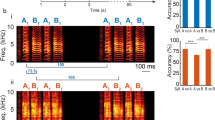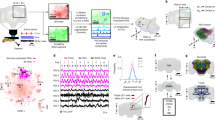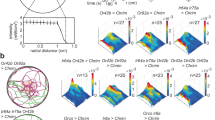Abstract
The recognition and localization of sound signals is fundamental to acoustic communication1,2. Complex neural mechanisms are thought to underlie the processing of species-specific sound patterns even in animals with simple auditory pathways3,4. In female crickets, which orient towards the male's calling song, current models propose pattern recognition mechanisms based on the temporal structure of the song5,6,7. Furthermore, it is thought that localization is achieved by comparing the output of the left and right recognition networks, which then directs the female to the pattern that most closely resembles the species-specific song8,9,10. Here we show, using a highly sensitive method for measuring the movements of female crickets, that when walking and flying each sound pulse of the communication signal releases a rapid steering response. Thus auditory orientation emerges from reactive motor responses to individual sound pulses. Although the reactive motor responses are not based on the song structure, a pattern recognition process may modulate the gain of the responses on a longer timescale. These findings are relevant to concepts of insect auditory behaviour and to the development of biologically inspired robots performing cricket-like auditory orientation11,12,13.
This is a preview of subscription content, access via your institution
Access options
Subscribe to this journal
Receive 51 print issues and online access
$199.00 per year
only $3.90 per issue
Buy this article
- Purchase on Springer Link
- Instant access to full article PDF
Prices may be subject to local taxes which are calculated during checkout




Similar content being viewed by others
References
Webster, D. B., Fay, R. R. & Popper, A. N. The Evolutionary Biology of Hearing (Springer, Berlin, New York, 1992)
Pollack, G. S. Analysis of temporal patterns of communication signals. Curr. Opin. Neurobiol. 11, 734–738 (2001)
Balakrishnan, R., von Helversen, D. & von Helversen, O. Song pattern recognition in the grasshopper Chorthippus biguttulus: the mechanism of syllable onset and offset detection. J. Comp. Physiol. A 187, 255–264 (2001)
Weber, T. & Thorson, J. in Cricket Behaviour and Neurobiology (eds Huber, F., Moore, T. E. & Loher, W.) 310–339 (Cornell Univ. Press, Ithaca, London, 1989)
Hoy, R. R. Acoustic communication in crickets: a model system of feature detection. Fed. Proc. 37, 2316–2323 (1978)
Schildberger, K. Temporal selectivity of identified auditory neurons in the cricket brain. J. Comp. Physiol. A 155, 171–185 (1984)
Hennig, R. M. Acoustic feature extraction by cross correlation in crickets? J. Comp. Physiol. A 189, 589–598 (2003)
Pollack, G. S. Discrimination of calling song models by the cricket, Teleogryllus oceanicus: the influence of sound direction on neural encoding of the stimulus temporal pattern and on phonotactic behaviour. J. Comp. Physiol. A 158, 549–561 (1986)
Stabel, J., Wendler, G. & Scharstein, H. Cricket phonotaxis: localization depends on recognition of the calling song pattern. J. Comp. Physiol. A 165, 165–177 (1989)
von Helversen, D. & von Helversen, O. Acoustic pattern recognition and orientation in orthopteran insects: parallel or serial processing? J. Comp. Physiol. A 177, 767–774 (1995)
Webb, B. Robots in invertebrate neuroscience. Nature 417, 359–363 (2002)
Webb, B. & Scutt, T. A simple latency-dependent spiking-neuron model of cricket phonotaxis. Biol. Cybern. 82, 247–269 (2000)
Arkin, R. C. Behaviour-Based Robotics (MIT, Cambridge, London, 1998)
Gerhard, H. C. & Huber, F. Acoustic Communication in Insects and Anurans (Univ. of Chicago Press, Chicago and London, 2002)
Huber, F. Cricket neuroethology: neuronal basis of intraspecific acoustic communication. Adv. Study Behav. 19, 299–356 (1990)
Pollack, G. S. Who, what, where? Recognition and localization of acoustic signals by insects. Curr. Opin. Neurobiol. 10, 763–767 (2000)
Popov, A. V. & Shuvalov, V. F. Phonotactic behaviour of crickets. J. Comp. Physiol. A 119, 111–126 (1977)
Doherty, J. A. Temperature coupling and trade-off phenomena in the acoustic communication system of the cricket, Gryllus bimaculatus de Geer (Gryllidae). J. Exp. Biol. 114, 17–35 (1985)
Murphey, R. K. & Zaretsky, M. D. Orientation to calling song by female crickets, Scasipedus marginatus (Gryllidae). J. Exp. Biol. 56, 335–352 (1972)
Ulagarai, S. M. & Walker, T. J. Phonotaxis of crickets in flight: attraction of male and female crickets to male calling songs. Science 182, 1278–1279 (1973)
Moiseff, A., Pollack, G. S. & Hoy, R. R. Steering responses of flying crickets to sound and ultrasound: mate attraction and predator avoidance. Proc. Natl Acad. Sci. USA 75, 4052–4056 (1978)
Schildberger, K., Huber, F. & Wohlers, D. W. in Cricket Behaviour and Neurobiology (eds Huber, F., Moore, T. E. & Loher, W.) 423–458 (Cornell Univ. Press, Ithaca, London, 1989)
Weber, T., Thorson, J. & Huber, F. Auditory behaviour of the cricket. I: Dynamics of compensated walking and discrimination paradigms on the Kramer treadmill. J. Comp. Physiol. A 141, 215–232 (1981)
Schmitz, B., Scharstein, H. & Wendler, G. Phonotaxis in Gryllus campestris L. (Orthoptera, Gryllidae). I: Mechanism of acoustic orientation in intact female crickets. J. Comp. Physiol. A 148, 431–444 (1982)
Doherty, J. A. Song recognition and localization in the phonotaxis behavior of the field cricket, Gryllus bimaculatus (Orthoptera: Gryllidae). J. Comp. Physiol. A 168, 213–222 (1991)
Weber, T. & Thorson, J. Auditory behaviour of the cricket. IV: Interaction of direction of tracking with perceived split-song paradigms. J. Comp. Physiol. A 163, 13–22 (1988)
Hedwig, B. A highly sensitive opto-electronic system for the measurement of movements. J. Neurosci. Methods 100, 165–171 (2000)
Pollack, G. S. & Hoy, R. R. Phonotaxis in flying crickets: neural correlates. J. Insect Physiol. 27, 41–45 (1981)
Nabatiyan, A., Poulet, J. F. A., de Polavieja, G. G. & Hedwig, B. Temporal pattern recognition based on instantaneous spike rate coding in a simple auditory system. J. Neurophysiol. 90, 2484–2493 (2003)
Cade, W. H. Effect of male deprivation on female phonotaxis in field crickets (Orthoptera: Gryllidae; Gryllus). Can. Entomol. 111, 741–744 (1979)
Acknowledgements
We thank our Cambridge and Edinburgh colleagues for comments on the manuscript. The BBSRC and the Royal Society supported the project. We are grateful to M. Knepper and P. Williams for the development of software and hardware and to Röhm GmbH for providing Rohacell.
Author information
Authors and Affiliations
Corresponding authors
Ethics declarations
Competing interests
The authors declare that they have no competing financial interests.
Rights and permissions
About this article
Cite this article
Hedwig, B., Poulet, J. Complex auditory behaviour emerges from simple reactive steering. Nature 430, 781–785 (2004). https://doi.org/10.1038/nature02787
Received:
Accepted:
Issue Date:
DOI: https://doi.org/10.1038/nature02787
This article is cited by
-
An auditory-responsive interneuron descending from the cricket brain: a new element in the auditory pathway
Journal of Comparative Physiology A (2022)
-
Imaging neural activity in the ventral nerve cord of behaving adult Drosophila
Nature Communications (2018)
-
El grillo è buon cantore: for Franz Huber on the occasion of his 90th birthday
Journal of Comparative Physiology A (2016)
-
Dissecting the Contribution of Sensory Cues to Directional Responses by Female Crickets in a two-Loudspeaker Paradigm
Journal of Insect Behavior (2016)
-
Divergence in male cricket song and female preference functions in three allopatric sister species
Journal of Comparative Physiology A (2016)
Comments
By submitting a comment you agree to abide by our Terms and Community Guidelines. If you find something abusive or that does not comply with our terms or guidelines please flag it as inappropriate.



